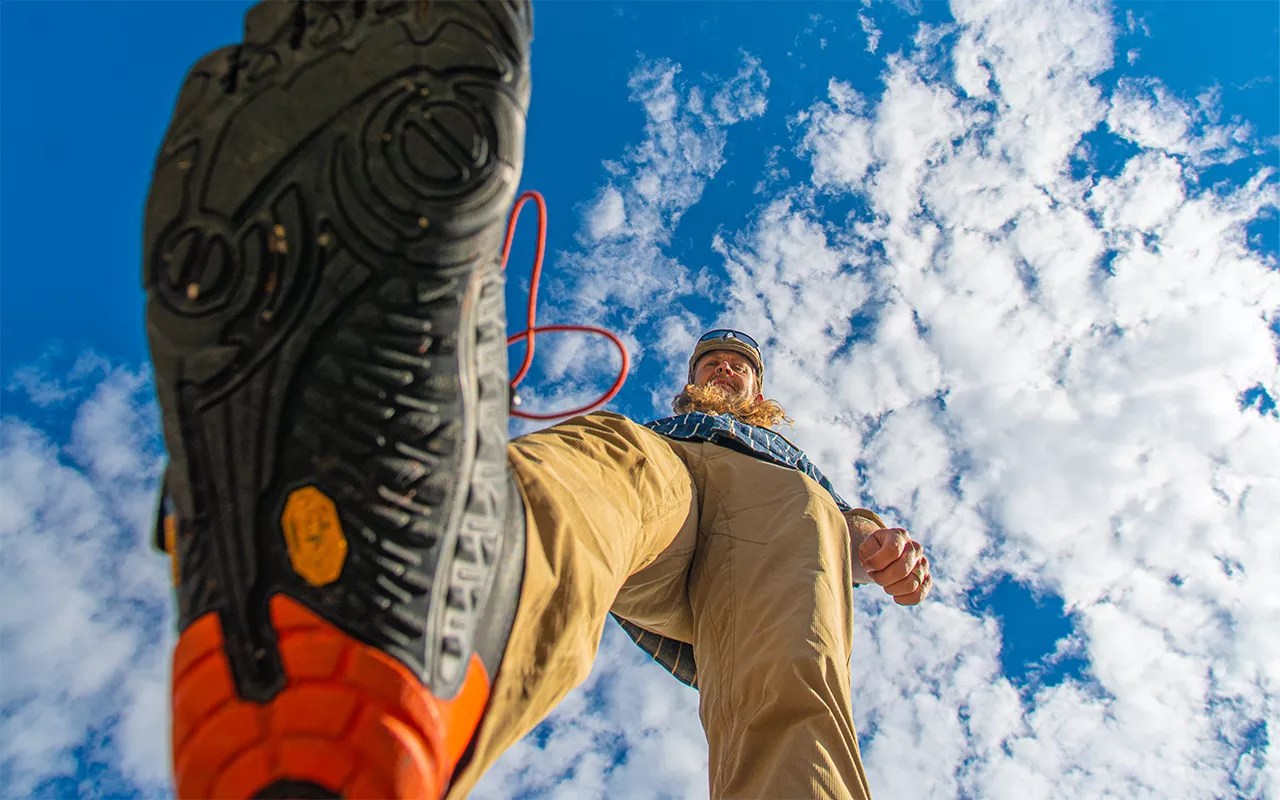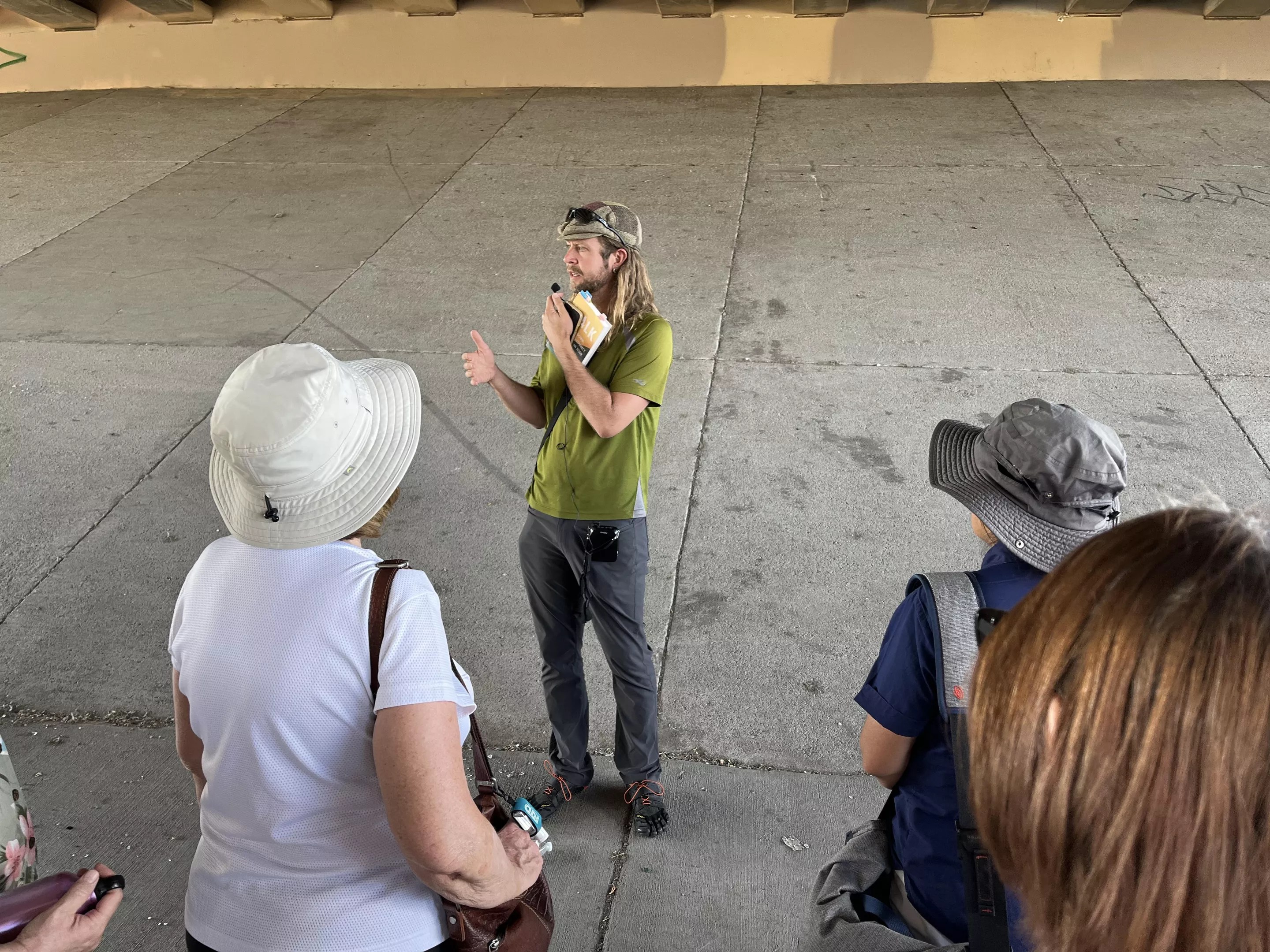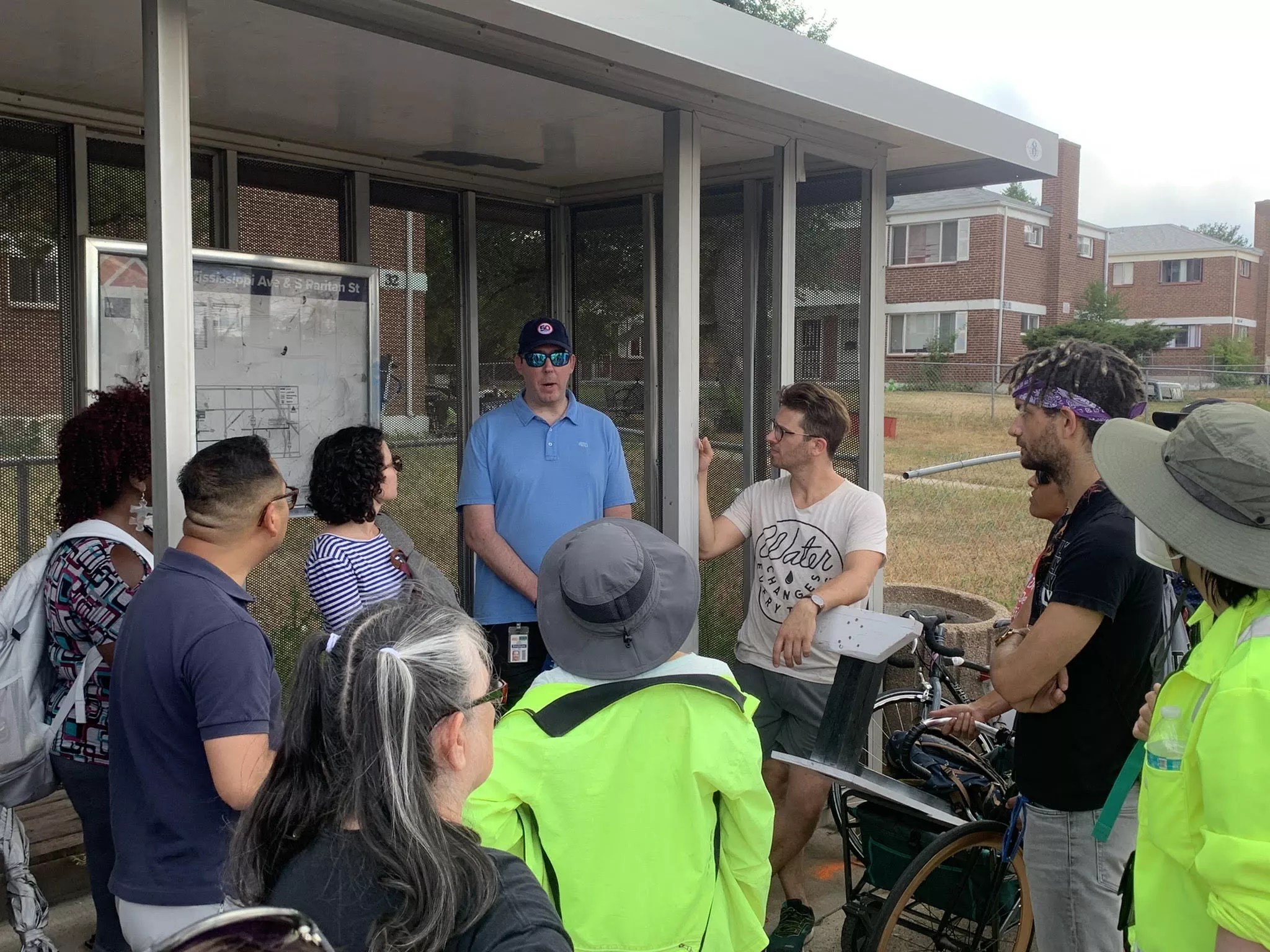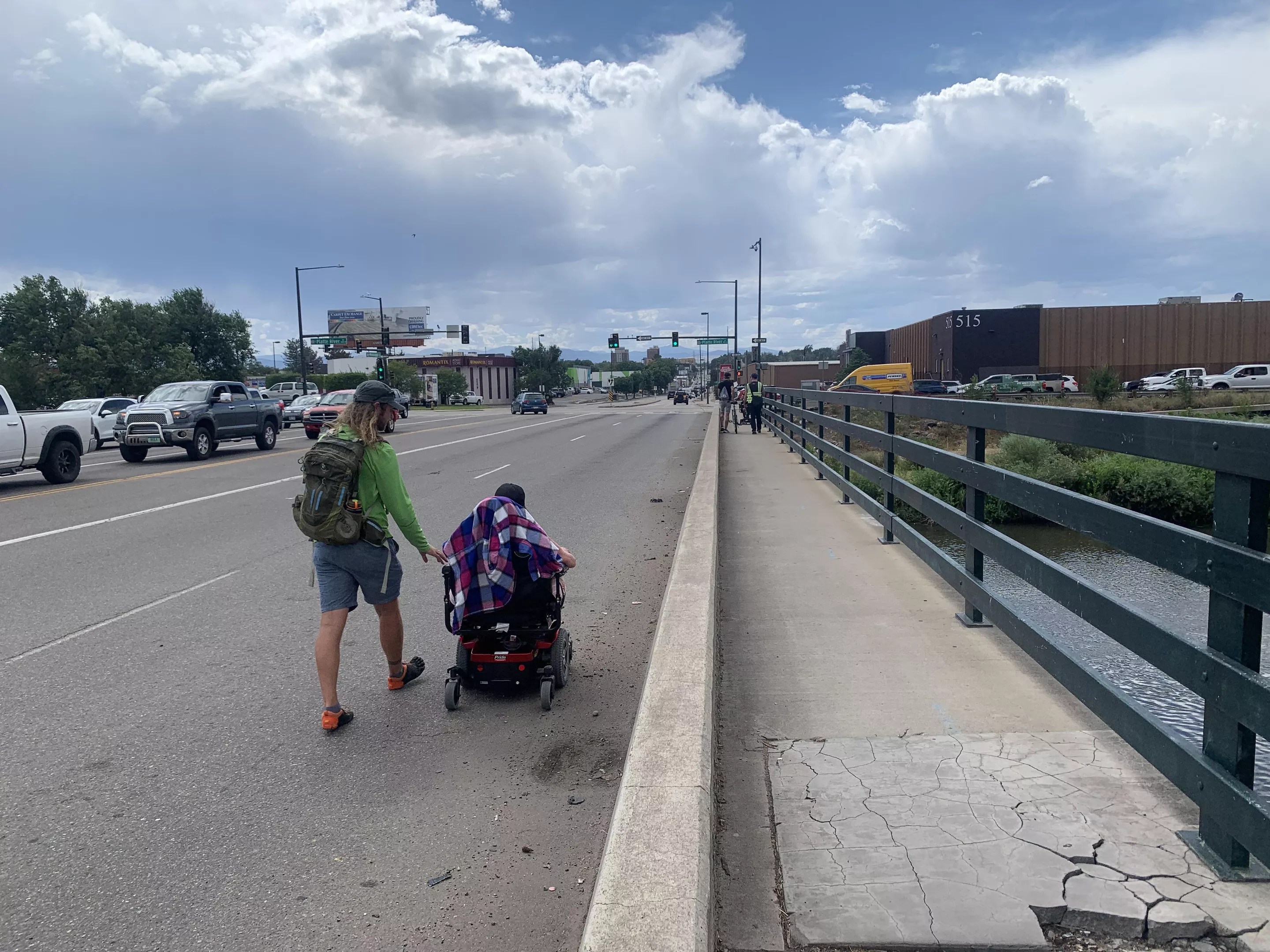
Evan Semon

Audio By Carbonatix
With the sounds of combustion engines clogging the ears of a few dozen people standing alongside West Colfax Avenue beneath Federal Boulevard, Jonathon Stalls begins to preach.
“I want you to just feel it, I want you to just smell it,” Stalls says. “It’s important that we’re in this tension. To just get in the car to drive by, it doesn’t serve the whole. It doesn’t service healing. It doesn’t service injustice. It doesn’t serve what we’re doing to the planet. It doesn’t serve to only bypass what’s actually going on. So I just invite that tension with love and some fire, because we need to love each other radically – and part of that is going into the tension.”
Stalls delivers these words on one of the first tour events for his new book, WALK: Slow Down, Wake Up, and Connect at 1-3 Miles per Hour, just published by North Atlantic Books. An advocate since 2010 for the power of walking and the dignity of people who don’t use cars to get around, he organized this event, which started outside the Corky Gonzales Library, to illustrate the thesis of his book through a powerful tool: walking.
Now forty, Jonathon Stalls wasn’t always a walker.
This year, make your gift count –
Invest in local news that matters.
Our work is funded by readers like you who make voluntary gifts because they value our work and want to see it continue. Make a contribution today to help us reach our $50,000 goal!
He was born in 1982 in Tampa Bay. His father, Dave Stalls, was a defensive tackle with the Tampa Bay Buccaneers who also played with the Cowboys and Raiders as well as the Denver Gold USFL team. Jonathon spent his earliest years bouncing around between Florida, California and Colorado.
“My father always stayed in Denver,” he says. “Denver was always a home base.”

Jonathon Stalls heads Pedestrian Dignity.
Evan Semon
But his parents split up when he was six, and Jonathon ended up living primarily with his mother and stepfather, who worked in the cell phone industry. The family moved around the country, from Wisconsin to Tennessee and West Virginia.
“I moved every two years as a kid. Ideas of ground and home were hard for me; I didn’t have a lot of stability growing up,” says Jonathon. “I was shuttled around, mostly in the suburbs, in a car with my face smashed against the window.”
While in middle school, he started to notice that when his male friends began talking about their feelings for girls, Jonathon himself was feeling a similar attraction toward boys. But by the time he got to high school, he’d “started mastering the art of putting on all of the masks,” he says.
“For me to get through the day, I had to…I had to pretend. I had to fit in in all these different ways.”
“I had to pretend. I had to fit in in all these different ways.”
When he was sixteen, Jonathon moved to Denver to be with his father, who’d founded a drop-in center for teens at 2109 Stout Street called the Spot. It “was basically a place for any young person kind of in the urban core – gang members, homeless teens, anybody who was moving through those streets,” he recalls.
His younger sister, Tracy, was there, too, and the two spent some of their formative years hanging out and bonding with gang leaders from the Denver Bloods and Crips, as well as homeless LGBTQ youth who’d been shunned by their families.
“Here’s Tracy and Jonathon on every other weekend, hanging out with guys who are definitely some of the most challenged young people in Denver at the time,” recalls Dave Stalls.
Adds Jonathon: “I always had this really unique urban-community kind of raw connection to the work that he did.”
Urban Peak, a Denver organization focused on serving homeless youth, took over the Spot in 2003 and has run it ever since. Dave Stalls continued working in nonprofits, serving as president and CEO of Big Brothers Big Sisters of Colorado; he also co-founded Street Fraternity, a center located on East Colfax Avenue near the Denver and Aurora border that fosters growth in young men primarily from refugee backgrounds.
Standing tall at 6’4″, Jonathon Stalls starred in basketball at Lakewood High School and received a verbal scholarship offer from the University of Northern Colorado, where his father had played on the football team decades earlier. But after he started practice, the coach told Stalls and another player that they’d have to redshirt for their freshman year because the program was taking on two Australian community-college transfers.
Stalls stuck it out at UNC for a year and then moved to Southern California, where he became a semi-professional beach volleyball player. He also studied art at a college in San Diego and got involved with a church group, trying to pray away the gay. He dated women but still felt attracted to men.
In 2005, Stalls moved to Ireland as part of his work with the church group. While he was finally able to come out openly as gay, he began to struggle with suicidal ideations, as he still felt uncomfortable being his true self in the world.
At the end of 2006, Stalls moved back to California to give semi-pro beach volleyball another go before ultimately giving up on the sport and returning to Colorado to finish school at Metropolitan State University of Denver.
After completing his undergraduate studies in design and entrepreneurship at MSU Denver, Stalls took a job in refugee resettlement at the African Community Center, where he worked with people who’d fled war and famine in countries like Somalia, Sudan, Ethiopia and Eritrea.
Through this refugee resettlement work, he saw firsthand what it was like for some people to have to navigate in a totally new country without a car. “I was literally just co-experiencing the harm, witnessing so many elders holding grocery bags in the rain without a shelter, getting sprayed right across the street from an apartment where they live,” Stalls remembers.

Jonathon Stalls learned how hard it was to live without a car.
Evan Semon
While in the job, he felt an urge to take a long journey to discover the country and find himself. “The original ache to do that was very personal,” he says. “I needed to recalibrate a lot of things.”
Stalls began planning for his trip by talking with other individuals who had walked across the United States. He studied the American Discovery Trail, a system of roads and trails that form a path across the country, and used it as both inspiration and a way to chart a route through a handful of major cities he wanted to stop in during his trek.
“The only thing that was somewhat set in stone for me was the big cities I wanted to get to. If these cities are my anchor points, then I can get creative and get the advice from local people in between them,” Stalls recalls.
Stalls raised money for the walk through an organization that provides loans to low-income entrepreneurs. With that partnership, he was able to get $10,000 to fund his journey.
He set off in March 2010, starting at Cape Henlopen State Park in Delaware. From there, he walked to Washington, D.C., then on through Cincinnati, St. Louis, Kansas City, Pueblo, south of Salt Lake City and San Francisco. “That was eight and a half months of walking through fourteen states, cities, in suburban, rural, desert and mountain landscapes,” Stalls says. He went through a pair of hiking shoes every month.
The journey offered a “whole new way of moving through the world,” allowing him “to listen and understand things from an unhurried walking perspective,” he says. For much of the walk, he was accompanied by his dog, Kanoa.
Although he camped outdoors some nights, Stalls also stayed with 120 strangers. The first to welcome him into her house lived in Maryland, and she sheltered Stalls and Kanoa from a cold, pouring rain. Stalls broke bread with an Ohio family on Easter Sunday.
The worst part of the trip was walking through Kansas City, says Stalls. “It was the heart of the humid, sticky, unforgiving summer,” with “flies, bugs, wetness,” he remembers. Kanoa, who is part husky, also struggled in the heat.
Both physically and mentally exhausted, Stalls thought about quitting. But he pressed on, realizing that he was also experiencing significant mental health benefits from walking, which he calls his own “medicine.” And he wanted others to experience that, too.
Stalls began posting online to see if people would like to walk with him for a day. A few people showed up initially, and then the groups began to grow. And he met more folks who wanted to help him.
An artist in Moab, Utah, housed him for a night, as did a woman who worked at an Old West saloon in Eureka, Nevada. Many of these connections happened spontaneously as people slowed their cars, rolled down a window and asked if Stalls needed anything.
His favorite part of the trek was walking through the high desert of Nevada.
“I had already walked through twelve states,” he recalls. “I was feeling so strong in my body. I was so open to what would show up in the desert. I wasn’t afraid of the desert. I thought I’d be terrified. But I was like, ‘Bring it on.'”
And he wasn’t just feeling freed up emotionally and spiritually. With no one in sight on Highway 50, Stalls took off his clothes and spent hours walking naked. “I would just have my pushcart without my clothes,” he says. “I had my shoes. I was just in these huge landscapes.”
Finally, after 3,030 miles, his cross-country walk ended at the Pacific Ocean.

Jonathon Stalls encourages walking tour participants to notice the smell of gasoline and the roar of cars.
Conor McCormick-Cavanagh
Stalls returned to Denver and began doing communications for the progressive faith-based advocacy organization Together Colorado, which works on issues like climate justice, immigration reform and criminal justice reform.
In 2012, he founded Walk2Connect, a business that trained community members, public officials and nonprofit leaders how to become walking leaders. Walk2Connect soon had a contract with Boulder and took city planners out on walks to show them how to lead their own treks around town with residents who wanted to talk about infrastructure and design.
Stalls and others involved with Walk2Connect eventually transitioned it from an LLC to a worker-owned cooperative. Through his work with the organization, he says he kept seeing the “raw, dehumanizing reality of that lived experience in all weather, every day, for people who get around by walking.”
Walk2Connect ultimately shut down during the pandemic, though Stalls says that the organization’s website is still maintained and that cities can continue to hire people associated with its network for walking leadership training.
But he’d already moved on, answering a call that “just kept getting louder and louder,” he says.
“I would host so many events with state transportation, city transportation officials. I would hear an uncountable amount of times, ‘I’ve never done this before, this is shocking, this is eye-opening. I’ve been working in these systems for twenty years.’ Unless you absolutely have to, why in the hell would you walk on it?” Stalls asks.
“I would host so many events with state transportation, city transportation officials.”
So he came up with a project that focused on people who use their feet, wheelchairs or public transit to get around. “I just really wanted to name this specific lens of pedestrian mobility,” says Stalls. He called it Pedestrian Dignity.
He began hosting Pedestrian Dignity events, inviting both regular citizens and government officials on walking tours to show them the lack of dignity afforded to pedestrians. But while the demonstrations worked in person, Stalls had a tough time sharing them.
“I started on Instagram, and I would just take videos via my phone. And I would try to use YouTube, but I was never great at creating longer-form YouTubes,” he admits.
In fall 2019, Stalls was hosting a Pedestrian Dignity event in west Denver when a young teenager he describes as “very artistic and amazing” told him that he needed to get on TikTok.
Stalls initially balked at the idea. But as he was heading home on the bus, he realized that he had been “asked by a young person to engage,” and that he should take the teen up on the offer. So he created a TikTok account.
He soon realized that it was the perfect medium, allowing him to be raw and in the moment. In June 2021, he created the Pedestrian Dignity TikTok page, and “it just took off,” says Stalls, who describes his experience on TikTok as simultaneously wild, amazing and hard.
He primarily makes videos that show undignified aspects of the pedestrian experience, like when a section of Denver caters totally to cars and is unpleasant or downright dangerous for pedestrians; he narrates the pieces. But when there are dignifying aspects of infrastructure, he’ll highlight those, too.
Pedestrian Dignity TikTok videos have led not just to connections, but to collective action in the real world.
“It feels to me like he’s been a person who has been doing this work for a long time, and because of TikTok, it just kind of exploded at the local level and maybe national,” says Alejandra Castañeda, a 48-year-old Denver resident and communications professional who reached out to Stalls after seeing one of his TikToks.
Castañeda now accompanies Stalls on many of his walks with government officials. “Every one of those events where I have been present, someone either from CDOT or DOTI or some other agency like RTD has said, ‘This is the most impactful thing. I’ve been working at X for ten or fifteen years, and this is the most impactful thing that I’ve done.’ Actually going out there and leading and feeling and facing all these different challenges. And I tell you this and I get goosebumps. Because how is it that people leading these agencies have not done this?” Castañeda asks.

RTD fixed this old bus shelter after being confronted by Pedestrian Dignity advocates.
Conor McCormick-Cavanagh
Justin Bai, a 24-year-old Ph.D. student in linguistics at the University of Colorado Boulder, also connected with Stalls after seeing TikTok videos on Instagram. “With Pedestrian Dignity, he doesn’t see it as a hierarchical thing where he’s the leader,” says Bai, who co-led a walk with RTD officials in west Denver in July.
Bai, who lives in Denver, has taken to organizing walks even outside of official Pedestrian Dignity events. In August, during RTD’s Zero Fare for Better Air initiative that made public transit free for a month, Bai challenged himself to visit every single RTD rail station in as short a time as possible. It took him just over eight hours and thirty minutes.
Using RTD isn’t just an experiment for Bai. “I’m someone who doesn’t drive. I can’t drive, because I don’t have a driver’s license,” he says.
Nica Cave, a software developer who relies on a wheelchair to get around, also met up with Stalls through Pedestrian Dignity’s social media. “Using a wheelchair as a pedestrian makes all of these issues in our infrastructure and issues of equity so much more present,” says Cave, noting that it highlights “just how much more difficult it is for people with disabilities to get around in our cities.”
Cave recently founded her own nonprofit advocacy organization, Human Centric Design, which focuses on the pedestrian mobility experience. “I call myself the glue between advocates and these agencies, because as one advocate, it’s a little bit difficult to talk to these different agencies. You kind of get shuffled around in the bureaucratic process,” she says. “We’re much more powerful as a group.”

Phyllis Mack sometimes has to roll in the street because of poor pedestrian infrastructure.
Conor McCormick-Cavanagh
In July, Cave and Bai organized a Pedestrian Dignity “walk and roll-around” with advocates and RTD officials that began at the Interstate 25 and Broadway light-rail station before continuing south down Broadway and then west along Mississippi Avenue.
“We will sort of select a section of a street that has very loud pedestrian problems – broken sidewalks, non-present crosswalks, just really dangerous roads that we rely on to get around,” says Cave. “We will choose a road that is personal to somebody.”
Stalls, who considers Pedestrian Dignity a non-hierarchical entity without a leader, was on that walk. As he does at most of these events, he encouraged participants to smell the gasoline, hear the loud noise of cars passing by and feel the lack of comfort and safety that pedestrians experience.
Seventy-four-year-old Phyllis Mack, who uses a wheelchair, was also on the trek. She lives in a Denver Housing Authority unit right near West Mississippi Avenue and South Raritan Street. “As you know, the sidewalks over here on this side of town are very small,” says Mack, who navigates them every day.
During the event, a bumpy and cracked curb cut at the intersection of Mississippi and Santa Fe forced Mack and others to move into the street instead of staying on the sidewalk. Stalls walked alongside her.
“It was rough. It was rough,” recalls Mack. “The sidewalks are very small, and they need to widen them instead of spending all the money on cars and all that kind of thing. They need to consider people with disabilities.”
The tour concluded at an RTD bus stop near Mississippi and Raritan. Standing beneath a shelter that looked like it hadn’t been touched since the ’80s, Pedestrian Dignity advocates were able to show firsthand how bad Denver can be for people who don’t use cars.
“I am happy to report that we were able to repair the bus shelter. And since that bus shelter is owned by RTD, we had the ability to fix it relatively quickly. That has been resolved. The bus shelter has been cleaned up and repaired,” says Brandon Figliolino, a senior community engagement specialist for RTD who was on the tour. “I definitely observed that the built environment is oriented toward vehicles. I appreciate them raising that awareness and showing that there are opportunities to improve the pedestrian infrastructure on roads and streets in the Denver metro area to make it easier for people to bike and walk to transit destinations.”
“I appreciate them raising that awareness and showing that there are opportunities to improve the pedestrian infrastructure.”
Why did it take a Pedestrian Dignity event to draw attention to the shelter? “We have a prioritization schedule,” Figliolino responds. “We make improvements based on essentially the safety risk of those situations. We will prioritize getting safety concerns repaired first over more aesthetic concerns.”
Stalls made a TikTok video of the event, which has already racked up over 15,600 views.
“Notice the new, wide, flat detached sidewalk that leads pedestrians, all who walk or roll into the chaos of traffic with no support. Pedestrian networks are so disconnected. We need our decision-makers to feel it and experience it,” Stalls says over the video, which features smooth jazz with a beat in the background and footage of Pedestrian Dignity advocates and RTD officials on the tour.
Stalls says he’s “constantly bringing origin and destination into the videos.” He notes what bus routes are nearby, and often films areas near public housing to show where pedestrians can find grocery stores, hospitals and schools.
“It’s where people are going. And then looking at the specifics of pedestrian mobility in comparison, in juxtaposition, in contrast to automobiles,” Stalls says.
Like the Pedestrian Dignity tours, which are year-round, the videos are made in all seasons. The purpose is to be really clear “how harmful and how much space the car takes up around a community, around where people live and where people are trying to go,” he adds.

Jonathon Stalls flies cross-country for book tour dates, but otherwise walks to any events he can.
Evan Semón
Stalls is now on a book tour, touting WALK: Slow Down, Wake Up, and Connect at 1-3 Miles per Hour.
“Some of the stories are part of journal entries from my walk in 2010. I kept journal entries, notes and reflections from the cross-country walk, Walk2Connect [and] other long-distance walking journeys in a large writing file, and kept returning to it over the years,” says Stalls, who says he formally began working on a book proposal in 2016, the same year he rediscovered the art he’d loved as a child. (He frequently posts stickers he’s created on his walks.)
“I wanted others, in their own ways, to connect to walking/unhurried movement as medicine, connection, humility, healing, justice and Earth care,” Stalls explains.
Although he flies to tour destinations, he tries to walk to his events. For example, he recently flew to Providence, Rhode Island, and then walked to New York City, stopping at cities and towns along the way for book tour events.
“It’s really important to me, primarily from this place of mental health and integrity and connection to the book, it’s my most healthiest state,” he says. “And it’s a book about walking, so energetically, it just always feels more integrating for me. … Getting in a car is jarring for me, especially if I’m doing any walking programming or anything related to the book.”
Stalls wrapped up an August book event by taking participants to Paco Sánchez Park for a live reading.
“It’s not all devastation and harm,” Stalls says. “There’s so much beauty when we can move with each other, shoulder to shoulder, side by side. Our bodies are moving forward, under an open sky.”